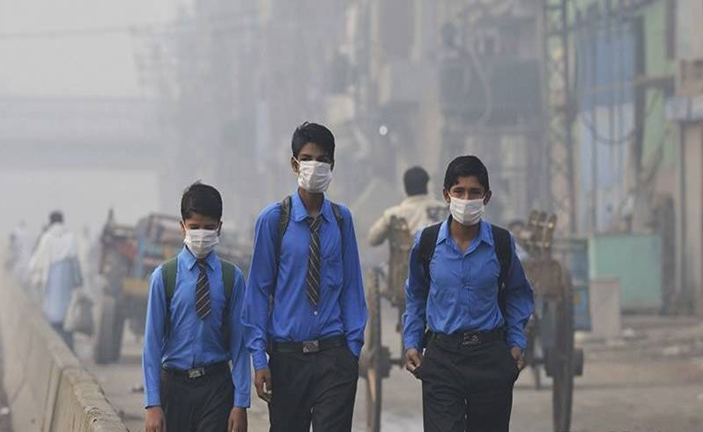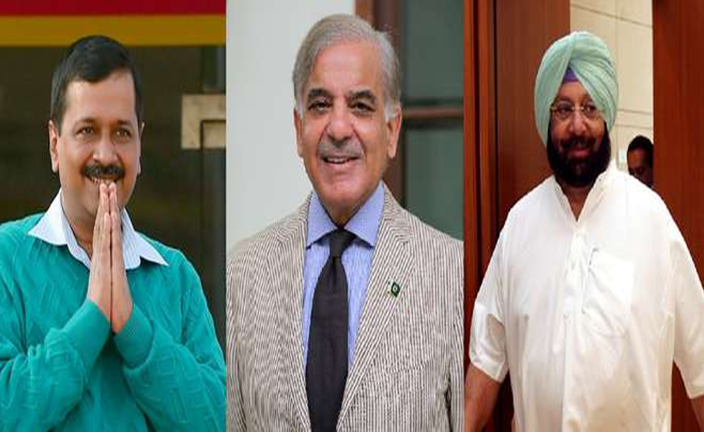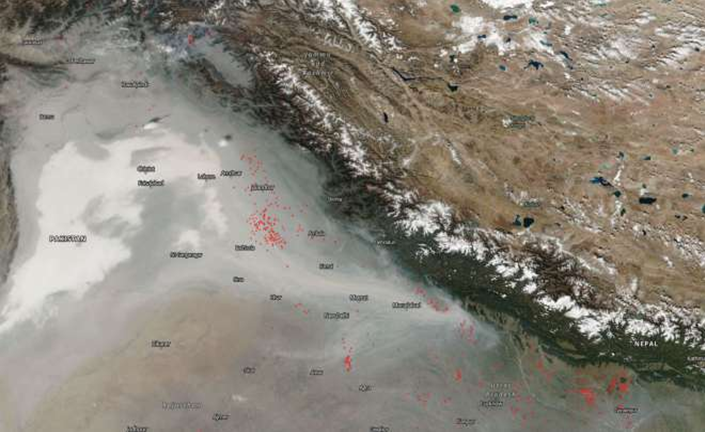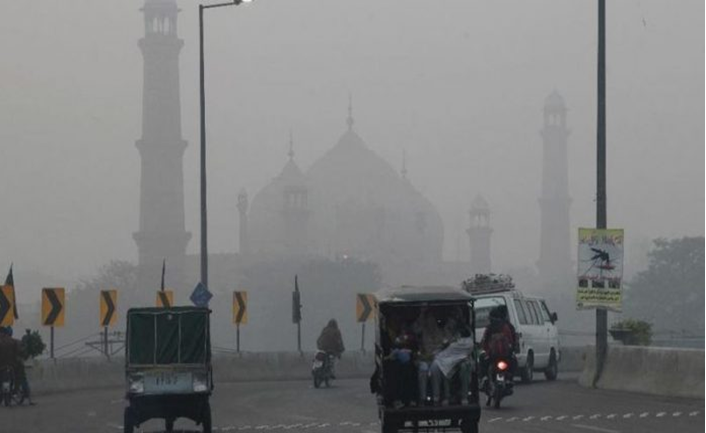By Humaira Saeed
 Lahore: The provincial government of the Punjab has prepared a policy to deal with the recurring problem of smog at this time of the year. The draft for the Policy on Controlling Smog 2017 has been prepared in consultation with the Environmental Protection Council (EPC) headed by Chief Minister Shehbaz Sharif and featuring 35 leading environmental experts on its board. These experts are responsible for providing expertise and advice on policy formation.
Lahore: The provincial government of the Punjab has prepared a policy to deal with the recurring problem of smog at this time of the year. The draft for the Policy on Controlling Smog 2017 has been prepared in consultation with the Environmental Protection Council (EPC) headed by Chief Minister Shehbaz Sharif and featuring 35 leading environmental experts on its board. These experts are responsible for providing expertise and advice on policy formation.
When Daily Times contacted a member of the board to seek his opinion on the draft, environmental lawyer Rafay Alam said it was hastily drawn out without proper consultation with the stakeholders as well as experts.
He said board members were given only a two-day notice to make themselves available for the meeting where the draft was to be reviewed. Resultantly, he and many others on the council were unable to attend the meeting to review the draft
“The lack of time given to the experts on the panel to deliberate on the policy has led to a hastily drawn out draft,” he said.
“The council was formed in 2012 with members from industries, academia and experts but it has since met only twice,” he said.
Alam said the draft had been prepared after the Lahore High Court ordered the EPC to formulate a policy to deal with the issue following last year’s spell of smog.
“Last year, the Punjab EPD possessed just one air quality monitoring metre for the city of Lahore. This year they have bought four more metres but these are still insufficient for the city,” he said. “No policy will be effective in tackling smog without adequate air quality monitoring equipment that can accurately tell us about the major pollutants in the city’s air,” he said.
“Unless we have metres, we cannot determine the exact source of air pollution. What would be the point of stopping farmers from burning crops if the actual problem is emissions from cars?” he asked. Controlling crop fires across the province is one of the key short-term measures mentioned in the policy draft available on the Environment Protection Department website.
Alam stressed the need to accurately identify the pollutants before proceeding with measures to control them. “We need to know if Lahore’s air pollution comes from emissions, crop burning or industrial activity. The metres can tell what’s in the air. Once we know the exact composition then we can find devise a solution,” he said.
Alam said there was a lack of political will to proceed on the issue. “When dengue fever hit Lahore, there was an immediate effort to clean up all stagnant water, and two years after the first major outbreak of the fever in the province, we were able to control it. “Regarding smog, there is not enough political will yet even though the Lahore High Court has also taken notice of the matter,” he said.
He said the private sector needs to be brought on board as well to invest in pollution control equipment. “The industry will need to be convinced to work for greener and more sustainable development. All stakeholders need to be involved,” he said.
Another problem identified by Alam was that the provincial government had previously not dealt with an issue of such a scale. “Air quality poses a management and governance problem of a scale that has not been dealt with by the government in the past. It is an integrated problem that cuts across sectors,” he said.
Another environmentalist Munir Ahmed who operates a non-government organisation based in Islamabad was sceptical that the policy would be translated into actions.
“We are good at making policies but our implementation mechanisms are poor,” he said.
Ahmed held that environmental watchdogs needed to be strengthened to control pollution effectively.
“The smog issue has been around for a while and it is no longer a local phenomenon. It has spread over the region and is now a trans-boundary challenge,” he said. “The biggest pollutants in the Punjab are automobiles. The industry also lacks any environmental regulation. Untreated industrial waste, sewage and solid waste all contribute to the problem,” he said.
“No step has been taken over the years to reduce air pollution. Instead, we are now seeing installation of coal-fired power plants in Punjab. This will intensify the problem. I strongly believe that the provincial government is ill-prepared to control the smog,” he said.
Ahmed resonated with Alam as he said that the provincial government needed to improve its ability to monitor air quality if it was interested in controlling smog. “It should set an example by developing a well-equipped, independent environment protection agency staffed with experts answerable to the legislature alone, not to the executive branch,” he said.
A source in the EPD told Daily Times that the recommended standard for cities was to have an air quality monitoring metre for every 300,000-500,000 persons in the population. Going by this standard, Lahore is extremely lacking in air quality monitoring metres.
However, when contacted, the EPD spokesperson maintained that six metres were enough for the time being. He said more metres would be installed when funds were available for the purpose.
Source : www.dailytimes.com.pk | NOVEMBER 2, 2017
Not Just Delhi, Pakistan’s Punjab Too Wants
Amarinder Singh To End Burning Of Crop Stubble
by Swarajya Staff Nov 10 2017

Arvind Kejriwal (L), Shahbaz Sharif, Captain Amarinder Singh (R)
The northern part of the Indian sub-continent has been reeling from poor air quality since last week. Not just Delhi, Pakistan’s cultural capital Lahore too suffers from poor air quality. The cause behind this problem is also common – burning of crop stubble in the Indian and Pakistani parts of Punjab.

The air in North India and Eastern Parkistan right now (NASA Earth Observing System Data and Information System (EOSDIS)
Soon after Delhi Chief Minister Arvind Kejriwal requested Punjab Chief Minister Captain Amarinder Singh on Twitter to take measures to end the practice and sought a meeting with him, government of Pakistan’s Punjab jumped into the conversation with its own request.
In a tweet early on Friday, the Shahbaz Sharif-led government in Pakistan’s Punjab said it has taken multiple measures to improve the quality of air, including a ban on stubble burning, and would like Singh to take similar measures.
Singh had on Thursday said that his state is helpless as the problem is widespread. Responding to Kejriwal’s request on Twitter, he said the state has ‘no money’ to compensate farmers for stubble management.
Source: https://swarajyamag.com/insta/not-just-delhi-pakistans-punjab-too-wants-amarinder-singh-to-end-burning-of-crop-stubble
In Lahore, Pakistan, Smog Has Become a
‘Fifth Season’
Don’t just blame India for the Lahore smog,
create India-Pak treaty on air pollution
By AMMARA AHMAD

Smog in Lahore, 5th December 2016 | Source: Wikimedia Commons
The smog has reminded us that India and Pakistan are connected in more ways than one.
Lahore: Lahore is covered in smog — though probably not as much as Delhi — but still extreme enough to cause an increase in road accidents, delay a cricket series with West Indies, shut down schools and stir a storm on social media.
But the Pakistani Punjab government’s explanation for this environmental hazard which is not uncommon in developed and developing countries is very frustrating. Almost everyone on this side of the border believes the stubble burning in Indian Punjab alone caused this smog.
Yes, NASA images confirm that the recent smog covers in northern India and Pakistan correlated with the burning of the paddy crop in late October.
This explanation hides a policy failure, is simplistic, disempowering and also reeks of a victimhood narrative not uncommon in Pakistan’s establishment.
This isn’t the first time Lahore has had a smog crisis. There was a milder though alarming enough version of it last year around this time. The Lahore High Court asked the Environmental Protection Department to attain air quality monitors and make policy. There is a policy, and the meters for measuring the air quality are also available, but the EPD’s response was slow, not timely.
Hence, blaming a neighboring country and injecting falsities in the popular narrative is as unhealthy as the smog itself.
Why has the Punjab government not focused on green technologies, taxes, incentives, and policies? Did the government make buying or parking cars more expensive while providing cheap and safe public transport available as in the case in the West? Are the emissions from industries, vehicles and rural sites monitored, reported and controlled?
There has to be scientific analysis into how much the crop-burning and coal power plant emissions from India compromise the air in Pakistan. Other factors like deforestation and sand storms from the Middle East may also play a role.
The government in Delhi tried the even-odd policy — a short-term measure, which cannot resolve the smog problem. Similarly, the Pakistan’s Punjab government has made crop and garbage burning illegal now that the province is nearly choked.
Pakistan is also the fastest urbanizsing country in South Asia — with an annual urbanising rate of 3 per cent. UN Population Division estimated that half the country would be living in cities by 2025.
Lahore’s population, which is now at seven million, will exceed 10 million by then. Smog has already sabotaged north India and Pakistan, and long-term policies are needed. No city in the world can sustain itself without formulating a clean air policy.
Lahore’s Orange Line Metro — a mass transit train line that will run across Lahore in 2018 is said to have caused the loss of 2,200 trees in the EIA report. Governments take pride in economic growth, not environmental preservation. Any long-term solution will require development projects to place the environmentalists next to, not far behind, the economists and financial experts.
Pakistani Punjab’s chief minister is the younger brother of former Prime Minister Nawaz Sharif who prides himself in good governance, development, and wants to turn Lahore into a modern infrastructural marvel and make Pakistan an ‘Asian Tiger’.
But why does it wait for Allah or India to fix the air pollution caused by this economic growth and industrialisation? Ultimately poor air or water quality and the consequent health emergencies will sabotage the GDP, and the public image of the country.
India and Pakistan should consider signing a new bilateral agreement like the ‘Indus Water Treaty’ but, this time, for air pollution control. One wonderful example of such a treaty is the ‘US-Canada Air Quality Agreement’. This treaty was initially meant to control “transboundary air pollution” and included “emissions limitations” and “reduction of pollutants”. The two countries were required to cut down sulphur dioxide and nitrogen oxides to control acid rain. The US has a similar treaty with Mexico since 2012 to reduce the pollution in the borderland.
Lastly, there is a need to empower the farmers in both the countries with the latest technology to stop them from burning the stubble to prepare the lands for the next crop.
India and Pakistan are always at odds with each other. The smog has reminded us that the two countries are connected in more ways than one. Any issues faced by one will spill over into the next quickly. We need to move on from this adolescent stage of blame game and come back to the table.
Source:
www.theprint.in | 10 November, 2017
Send email to nazeerkahut@punjabics.com with questions, comment or suggestions
Punjabics is a literary, non-profit and non-Political, non-affiliated organization
Punjabics.com @ Copyright 2008 - 2018 Punjabics.Com All Rights Reserved
Website Design & SEO by Webpagetime.com





